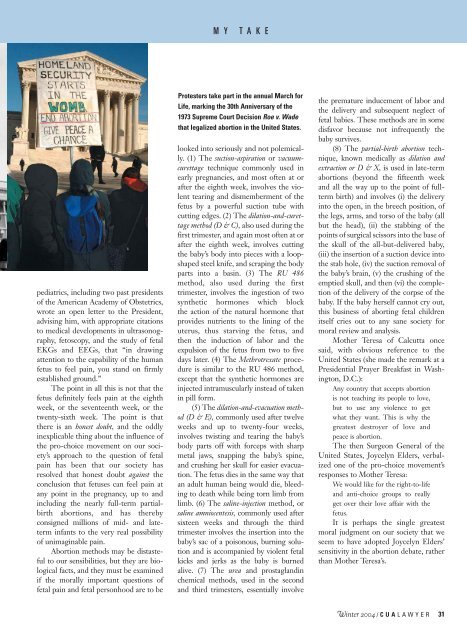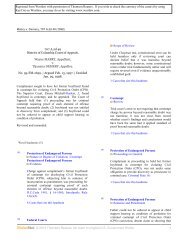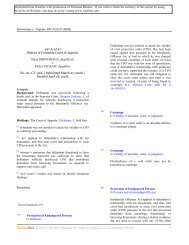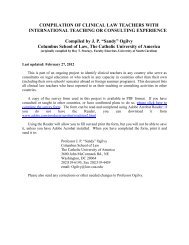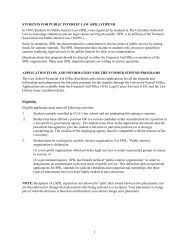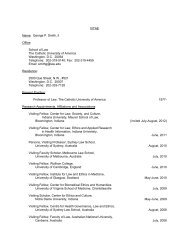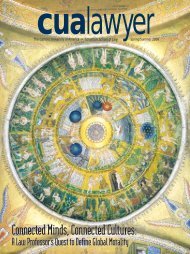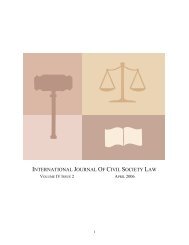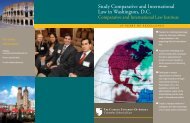CUA Cover Winter 2004 final (Page 2) - Columbus School of Law
CUA Cover Winter 2004 final (Page 2) - Columbus School of Law
CUA Cover Winter 2004 final (Page 2) - Columbus School of Law
- No tags were found...
Create successful ePaper yourself
Turn your PDF publications into a flip-book with our unique Google optimized e-Paper software.
M Y T A K Epediatrics, including two past presidents<strong>of</strong> the American Academy <strong>of</strong> Obstetrics,wrote an open letter to the President,advising him, with appropriate citationsto medical developments in ultrasonography,fetoscopy, and the study <strong>of</strong> fetalEKGs and EEGs, that “in drawingattention to the capability <strong>of</strong> the humanfetus to feel pain, you stand on firmlyestablished ground.”The point in all this is not that thefetus definitely feels pain at the eighthweek, or the seventeenth week, or thetwenty-sixth week. The point is thatthere is an honest doubt, and the oddlyinexplicable thing about the influence <strong>of</strong>the pro-choice movement on our society’sapproach to the question <strong>of</strong> fetalpain has been that our society hasresolved that honest doubt against theconclusion that fetuses can feel pain atany point in the pregnancy, up to andincluding the nearly full-term partialbirthabortions, and has therebyconsigned millions <strong>of</strong> mid- and lateterminfants to the very real possibility<strong>of</strong> unimaginable pain.Abortion methods may be distastefulto our sensibilities, but they are biologicalfacts, and they must be examinedif the morally important questions <strong>of</strong>fetal pain and fetal personhood are to beProtesters take part in the annual March forLife, marking the 30th Anniversary <strong>of</strong> the1973 Supreme Court Decision Roe v. Wadethat legalized abortion in the United States.looked into seriously and not polemically.(1) The suction-aspiration or vacuumcurettagetechnique commonly used inearly pregnancies, and most <strong>of</strong>ten at orafter the eighth week, involves the violenttearing and dismemberment <strong>of</strong> thefetus by a powerful suction tube withcutting edges. (2) The dilation-and-curettagemethod (D & C), also used during thefirst trimester, and again most <strong>of</strong>ten at orafter the eighth week, involves cuttingthe baby’s body into pieces with a loopshapedsteel knife, and scraping the bodyparts into a basin. (3) The RU 486method, also used during the firsttrimester, involves the ingestion <strong>of</strong> twosynthetic hormones which blockthe action <strong>of</strong> the natural hormone thatprovides nutrients to the lining <strong>of</strong> theuterus, thus starving the fetus, andthen the induction <strong>of</strong> labor and theexpulsion <strong>of</strong> the fetus from two to fivedays later. (4) The Methrotrexate procedureis similar to the RU 486 method,except that the synthetic hormones areinjected intramuscularly instead <strong>of</strong> takenin pill form.(5) The dilation-and-evacuation method(D & E), commonly used after twelveweeks and up to twenty-four weeks,involves twisting and tearing the baby’sbody parts <strong>of</strong>f with forceps with sharpmetal jaws, snapping the baby’s spine,and crushing her skull for easier evacuation.The fetus dies in the same way thatan adult human being would die, bleedingto death while being torn limb fromlimb. (6) The saline-injection method, orsaline amniocentesis, commonly used aftersixteen weeks and through the thirdtrimester involves the insertion into thebaby’s sac <strong>of</strong> a poisonous, burning solutionand is accompanied by violent fetalkicks and jerks as the baby is burnedalive. (7) The urea and prostaglandinchemical methods, used in the secondand third trimesters, essentially involvethe premature inducement <strong>of</strong> labor andthe delivery and subsequent neglect <strong>of</strong>fetal babies. These methods are in somedisfavor because not infrequently thebaby survives.(8) The partial-birth abortion technique,known medically as dilation andextraction or D & X, is used in late-termabortions (beyond the fifteenth weekand all the way up to the point <strong>of</strong> fulltermbirth) and involves (i) the deliveryinto the open, in the breech position, <strong>of</strong>the legs, arms, and torso <strong>of</strong> the baby (allbut the head), (ii) the stabbing <strong>of</strong> thepoints <strong>of</strong> surgical scissors into the base <strong>of</strong>the skull <strong>of</strong> the all-but-delivered baby,(iii) the insertion <strong>of</strong> a suction device intothe stab hole, (iv) the suction removal <strong>of</strong>the baby’s brain, (v) the crushing <strong>of</strong> theemptied skull, and then (vi) the completion<strong>of</strong> the delivery <strong>of</strong> the corpse <strong>of</strong> thebaby. If the baby herself cannot cry out,this business <strong>of</strong> aborting fetal childrenitself cries out to any sane society formoral review and analysis.Mother Teresa <strong>of</strong> Calcutta oncesaid, with obvious reference to theUnited States (she made the remark at aPresidential Prayer Breakfast in Washington,D.C.):Any country that accepts abortionis not teaching its people to love,but to use any violence to getwhat they want. This is why thegreatest destroyer <strong>of</strong> love andpeace is abortion.The then Surgeon General <strong>of</strong> theUnited States, Joycelyn Elders, verbalizedone <strong>of</strong> the pro-choice movement’sresponses to Mother Teresa:We would like for the right-to-lifeand anti-choice groups to reallyget over their love affair with thefetus.It is perhaps the single greatestmoral judgment on our society that weseem to have adopted Joycelyn Elders’sensitivity in the abortion debate, ratherthan Mother Teresa’s.<strong>Winter</strong> <strong>2004</strong> / C UALAWYER 31


